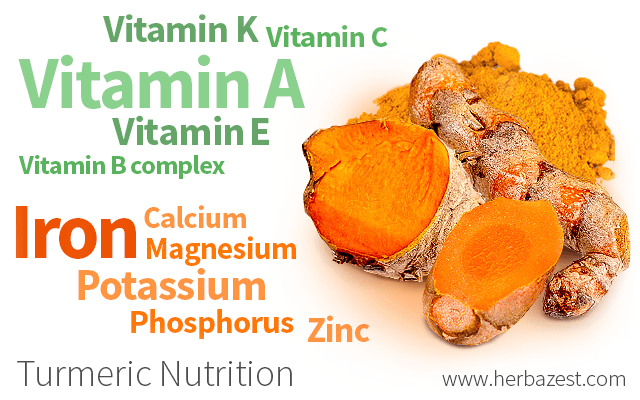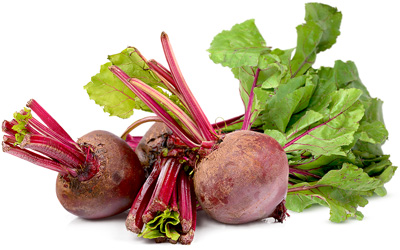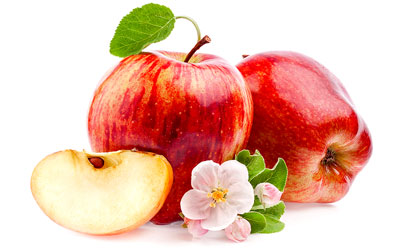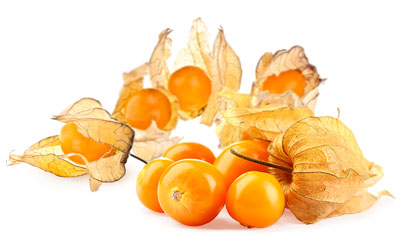Traditional medicinal systems of China and India have long endorsed turmeric for its numerous therapeutic properties. Practical applications of the herb often include its treatment of ailments related to digestion, pain, inflammation, and liver function.
In recent years, modern science has substantiated some of turmeric's nutritional benefits through studies of its active compounds, such as curcumin, and its other essential ingredients.
Turmeric's Essential Nutrients
Vitamins and minerals are among the most significant components that contribute to turmeric nutrition.
Turmeric Vitamins
Essential vitamins in turmeric include:
- Vitamin A (retinol). This antioxidant vitamin is crucial for vision health as well as for tissue regeneration, teeth, hormonal function, and hair growth.
Eight B-group vitamins. These vitamins have been shown to improve mental performance as well as contribute to the production of blood cells.
Vitamin E. This is a fat-soluble antioxidant that protects the skin, supports the immune system, and prevents the formation of blood clots.
- Vitamin C (ascorbic acid). A powerful antiviral and antioxidant, vitamin C helps prevent cellular damage.
- Vitamin K. Turmeric contains significant amounts of this vitamin, which promotes calcium absorption in the bones and coagulation.
Turmeric Minerals
Minerals are essential for proper nutrition. Iron plays a significant role in the production of hemoglobin, which provides the muscles and other parts of the body with fresh oxygen from the lungs. Iron deficiency can lead to anemia, which is characterized by fatigue, memory loss, and a decreased ability to fight off infections.
Turmeric also contains calcium, magnesium, zinc, phosphorus, and particularly large amounts of potassium. All these minerals play an important role in cellular metabolism, promoting immune function and energy production, as well as stable blood pressure and blood sugar levels.
TWO TEASPOONS OF GROUND TURMERIC AMOUNT TO ABOUT 3% OF THE RECOMMENDED DAILY INTAKE OF POTASSIUM.
Other notable turmeric ingredients include proteins, carbs, and fiber.
Supporting Compounds in Turmeric
The bright yellow phenolic compound, curcumin, is what gives turmeric its distinctive coloring and pleasant aroma. It is perhaps the most valuable substance in turmeric, performing a host of simultaneous medicinal actions. Curcumin and its other related compounds hold anti-inflammatory, antioxidant, and carminative properties that greatly contribute to the overall nutrition turmeric offers.
Because it lowers histamine levels, curcumin is able to effectively reduce inflammation.1 Though not as well-studied, the aromatic constituent turmerone in turmeric is an important part of its mechanisms of action, likely working in conjunction with curcumin to perform a number of different anti-inflammatory activities.
Meanwhile, the antioxidant activity in turmeric is comparable to vitamin E and vitamin C and protects the skin from damage caused by free radicals in the body.2,3 Sodium curcuminate, or salt from curcumin, increases bile solubility and expels bile salts and cholesterol from the body, which explains the benefits of turmeric for liver health.4
Moreover, though the exact means of blood clot prevention remains debated, it is believed to be a direct result of curcumin's role in supporting the formation of prostacyclin - a compound that helps prevent platelet clumping - and inhibiting thromboxane synthesis.
Other significant nutrients in turmeric include its supply of coumaric acid and zingiberones.
Turmeric Nutrition Facts
Turmeric is fat soluble, so it is better to consume it with healthy fats or black pepper for optimal absorption of its nutrients.
Turmeric's curcumin stimulates bile production and may be a useful for treating gallstones.5
100 grams of ground turmeric contain approximately 4.5 mg of vitamin E.
Turmeric is a good source of carbohydrates - which the body uses for energy - and dietary fiber, which is used for curbing appetite with a feeling of satiety and maintaining a healthy body weight.
Turmeric has earned an important role in dental care due to its anti-inflammatory properties. The teeth and gums are often rubbed with a paste made from fresh or roasted ground turmeric to heal pain and swelling associated with gingivitis and periodontitis.6
In cases of acute inflammation, curcumin can be as effective as cortisone or phenylbutazone.7
Turmeric contains potassium, an essential nutrient that builds proteins and muscle.
Turmeric has a rich nutritional profile. With vitamins, phytocompounds, and other ingredients, turmeric's benefits have been largely confirmed through present-day scientific studies- one reason for which people all over the world believe themselves to have struck gold with its cultivation.
Sources
- Herbal Medicine: Biomolecular and Clinical Aspects, Chapter 13: Turmeric, the golden spice
- Journal of Natural Science, Biology, and Medicine, Role of curcumin in systemic and oral health: An overview, 2013
- National Institutes of Health, Vitamin C | Vitamin E | Magnesium | Iron | Zinc | Calcium | Potassium in diet | Protein, carbohydrates, and fats
- Turmeric for Health: 100 Amazing and Unexpected Uses for Turmeric, pp. 10, 17, 19-20
- Turmeric: The genus Curcuma, pp. 297-301
- USDA Nutrient Database, Spices, turmeric, ground
- Medicinal Plants of the World, p. 118
- Power Foods, pp. 348-349
Footnotes:
- Molecular Nutrition Food Research. (2008). Immunomodulatory effects of curcumin in allergy. Retrieved October 5, 2021, from: https://onlinelibrary.wiley.com/doi/abs/10.1002/mnfr.200700293
- Nutrients. (2019). Potential of Curcumin in Skin Disorders. Retrieved October 5, 2021, from: https://www.ncbi.nlm.nih.gov/pmc/articles/PMC6770633/
- Life Sciences. (2014). Curcumin as a wound healing agent. Retrieved October 5, 2021, from: https://pubmed.ncbi.nlm.nih.gov/25200875/
- Nutrients. (2018). Curcumin in Liver Diseases: A Systematic Review of the Cellular Mechanisms of Oxidative Stress and Clinical Perspective. Retrieved October 5, 2021, from: https://www.ncbi.nlm.nih.gov/pmc/articles/PMC6073929/
- Lipids in Health and Disease. (2015). Combination of curcumin and piperine prevents formation of gallstones in C57BL6 mice fed on lithogenic diet: whether NPC1L1/SREBP2 participates in this process?. Retrieved October 5, 2021, from: https://pubmed.ncbi.nlm.nih.gov/12495265/
- Ayu. (2015). Comparative evaluation of turmeric gel with 2% chlorhexidine gluconate gel for treatment of plaque induced gingivitis: A randomized controlled clinical trial. Retrieved October 5, 2021, from: https://www.ncbi.nlm.nih.gov/pmc/articles/PMC4784123/
- Acta Cirurgica Brasileira. (2014). Oral administration of curcumin (Curcuma longa) can attenuate the neutrophil inflammatory response in zymosan-induced arthritis in rats. Retrieved October 5, 2021, from: https://pubmed.ncbi.nlm.nih.gov/25424293/
- Agents Actions. (1984). Anti-inflammatory and irritant activities of curcumin analogues in rats. Retrieved October 5, 2021, from: https://pubmed.ncbi.nlm.nih.gov/7180736/




